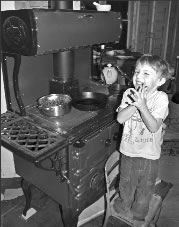by Mark Minor
Three years ago, at age 98, my house received a new heart. Judging from the evidence, its last heart was removed some time in the 1940’s. That heart used to be warm, the center of life and activity and sustenance. It was fed daily, cleaned, and loved. And I’m sure it gave back, in wonderful meals for its people.
The new heart was, yes, a wood cookstove, and its 400 pound mass arrived on an oak pallet. Coming from Ireland, it was, appropriately, shiny green. Ensconced once again at the center of all that is this house, it promptly consumed its pallet, and the warm magic returned to this kitchen.

Why, in the 21st century, in the midst of technology that would boggle the minds of folks of just two decades ago, does anyone actually choose to cook their food on a wood cookstove? Even more—why might they actually enjoy it?
A wood cookstove is less an object than a state of mind, a way of living. Slower, dirtier, more labor intensive. But it is more deliberate, more connected, warmer, more….mindful. I offer the following, not as a manual of wood cooking—there is plenty of material out there on that– but as an exploration of how in cooking our meals, this wonderful piece of iron ultimately cooks us.
It is a typical 5:20 am. The old house is dark, and cold. Part of the morning’s ritual is to open the firebox of the cookstove, and check the embers. If last night’s fire was made well, and the wood chosen carefully, there will be a faint glow from a small pile of still smoldering chunks. Tendrils of smoky air waft out of the firebox. Several dry sticks of kindling are put in, perhaps an old piece of junk mail, and the chimney damper opened. An audible suck of air announces the reborn fire, and dim yellow light dances around the margins of the open air regulator.
Soon, several larger pieces of wood can be thrown in as well. The kettle is filled with water, and carefully placed close enough to heat well, but far enough away from the firebox to not boil. I take advantage of the peacefulness of this time for 30 minutes of quiet sitting (zazen) each morning.
At 6 a.m. I can return, close the damper, gently move the kettle over to the hot part, and within a minute it will cheerfully whistle. The house is otherwise silent and I take care; too much kitchen clanging does violence to this peace. Lights of other homes in the valley turn on one by one as tea is made. Sitting in front of the stove, my back is delightfully warmed, and the toasty rice kernels in the Genmaicha tea compliment the faint fire smells. Hot tea in counterpoint to the snowy ground outside, as the eastern horizon begins to slightly glow.
Sometimes it seems appropriate to jot a few thoughts down in these early hours. The starkness of winter mornings seems very conducive to haiku. Here is one that came about on a morning just like this:
Stirred in cold darkness,
sleepy embers awaken.
Soon we will drink tea.
By the time breakfast is being eaten, a whole host of activities and sensations have taken place. But by the understanding of our busy world today, “nothing” has really happened here. Just the quirky actions of a 49 year-old hillbilly Zen student.
It is interesting that often what poses as “conveniences” in our lives today are really things that ultimately disconnect us from our lives. In order to make more time for what we see as the “meat” of our lives, we paradoxically avoid the things that are the” heart” of our lives. We even spend lots of time and money to acquire these conveniences. Most of us live in a state of striving and desire for a better situation, a more pleasurable present. Projecting ourselves into some potential future, when all we truly have is this incessant “now” moment. How hard it is to see the equality of importance of all our tasks, all our moments. Can we honestly say, “for the next ten minutes, my life doesn’t matter, because I am making oatmeal”? Is sweeping the ashes from the fire box any less special than buying your son a birthday gift? Is rushing to a meeting with an accountant more important than splitting the wood that will heat your home and cook your family’s sustenance? Perhaps.
This is the heart of a large problem we collectively have today. We microwave a crappy frozen dish, so that we can shorten the sustenance portion of our life in order to get to some other activity or “need” that we value more, like hitting that mountain bike trail.
A friend in New Mexico told me about how he and his wife were very involved in the “Slow Food” movement, and how they shared this passion with other similar-minded folks there. I guess I am really sheltered, because I chuckled and asked him what “slow food” was – beef instead of rabbit? I resisted the temptation to tell him that everything we eat at home is cooked on my wood cookstove, including all the bread we consume. That my closest neighbor also cooks on a wood stove. Alas, this isn’t a competition to see who can be the biggest Luddite. I imagine the value my friend and his wife get from the careful, mindful preparation of food—what this movement calls “slow food”—is very much on par with the reason I choose to cook on a wood cookstove. A pot of beans or stock simmers all afternoon on the far right, cooler part of the cook top. The smells drift through the house like incense, mixing with the occasional waft of smoke when the door is opened to check the fire. You don’t turn a lever or a switch to start the heat. Gas or electricity, from some far off, unseen locale, made, processed and delivered by far off, unseen people, does not appear with a turn of the wrist. Everything must be done mindfully an hour or so in advance. The vegetables to be sauteed at 6:00 must have a fire by 5:00. This fire must have dry wood, and dry kindling. The wood pile must be covered during a snow or rain if it is to be dry enough to make my dinner tomorrow and the next day, and the day after that. And every single piece of that wood must ultimately be handled four or five times.
In the early light after breakfast, the air is still very cold. My axe splits a log with a decided CRACK! A dog across the valley barks, and a young buck who bedded down beneath the fir tree decides I’m a little too active for his liking and wanders off. Examining the newly split half-round of wood, I guess there are 60 or 70 rings. Not a big log, for sure.. But it occurs to me that 70 rings represent a greater life span than that which my father enjoyed. This log was a sapling during the Great Depression. Where did it grow? How many bucks rubbed the velvet from their antlers on its bark? Surely there were many summer lightning strikes that came oh-so-close. Thousands of long, dark, and bitter-cold nights. Just one would be enough to kill me, and here I am, dismembering this tree’s carcass for my hearth, to warm me, my family, and our food.
All work that lies behind the simple heating of broccoli is important and valuable; it’s beautiful and necessary. It is part of “what really matters”.
My house’s heart is warm and strong now. There was a slightly troubled air about the place when it first let me stay here — but the house is more peaceful now, with the usual bodily troubles that plague any centenarian. Right here and now, the tangy scent of rising sourdough drifts from the warming shelf near the chimney, and a kettle of water murmurs, just shy of boiling. Tonight’s beans are soaking. Life is happening.
Of course, writing about a wood stove is an expedient and metaphorical exercise. And at the same time, it is not. The wheel turns – wood goes in, fires burn, water boils. A child sleeps. Shoes are tied. Stamps are put on letters. Friends shake hands or hug. A raven flies west. Moonlight shows deer tracks in the snow.
And all is as it now is, perfect. Svaha.
Mark Minor lives in Howard, CO., in a stone house with a big woodpile beside it. When not being a father, domestic partner or accordion player, he is actively engaged in the quest for the perfect loaf of sourdough bread.



